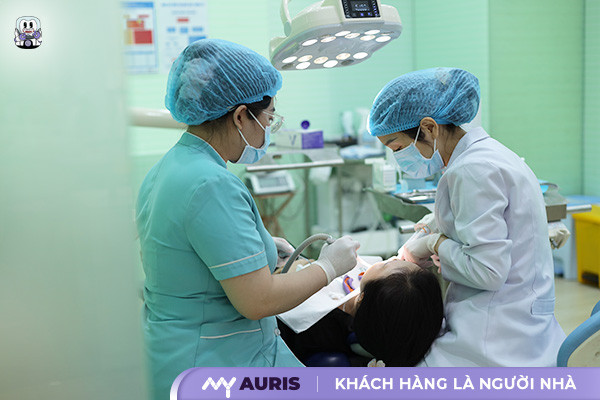If you are considering braces to correct crooked teeth, misaligned teeth, underbite, gaps, or overbite, then you should definitely learn about the orthodontic mini-screw technique – an advanced orthodontic tool that helps speed up the treatment process and achieve higher effectiveness.
At My Auris Dental Clinic, we apply this method to optimize orthodontic traction, delivering consistently beautiful and long-lasting results. So, what are orthodontic mini-screws, who needs them, and what are their uses? The article below will help you understand more, from the professional perspective of an experienced orthodontist, helping you feel more confident as you embark on your journey to a better smile.
What are Orthodontic Mini-screws used for?
Along with the traction force from brackets and elastic bands, orthodontic mini-screws play a crucial supporting role in moving teeth to their desired positions. Orthodontic screws are spiral posts made from titanium or special metals, implanted into the jawbone to act as anchors for forces applied to the teeth, helping to move teeth according to the dentist’s plan. Mini-screws are typically small, varied in type, with diameters ranging from 1.4-2mm and lengths from 6-12mm.
Before the advent of mini-screws, finding stable anchorage points in the mouth was very difficult. However, with the introduction of mini-screws, treatment time has been significantly shortened, optimizing the process and providing better control over tooth movement.
Cases where mini-screw implantation is indicated include:
– Closing spaces after tooth extraction, correcting overjet or underbite.
– Adjusting tooth positions, intruding or extruding teeth.
– Moving the entire arch.
– Changing the occlusal plane.
– Uprighting teeth to improve occlusion.

Cases Requiring Orthodontic Mini-screw Technique
The orthodontic mini-screw technique is a crucial method for achieving optimal treatment efficacy in many orthodontic cases. Below are the situations where this technique is necessary:
Overjet or Protruding Teeth
Overjet or protruding teeth, which extend outwards and result in an improper bite, not only detract from facial harmony but also reduce chewing function. In such cases, in addition to using brackets and archwires, dentists often prescribe the mini-screw technique to increase traction force, helping to move teeth to their correct positions on the dental arch, thereby improving both aesthetics and chewing function.
Gummy Smile
A gummy smile often makes many clients feel self-conscious when smiling and communicating. To correct this condition, the dentist will recommend placing orthodontic mini-screws to generate intrusive force, thereby correcting the jaw to the proper bite and helping teeth become more even and balanced, enhancing the patient’s confidence.
Severely Rotated Teeth
When teeth are severely rotated, a significant force is required to move them into the correct position. In this situation, in addition to the combined forces from brackets and archwires, the involvement of orthodontic mini-screws is essential to ensure the desired orthodontic outcome. The mini-screw technique helps ensure precise and effective tooth movement.

Standard and Effective Orthodontic Mini-screw Placement Procedure
Orthodontic mini-screw placement is a crucial technique in the orthodontic process, requiring strict adherence to procedures and techniques to minimize pain and reduce the risk of complications for the patient. Here is the specific mini-screw placement procedure you need to know:
Step 1: X-ray Scan to Survey Jawbone Structure
Before placing the mini-screw, the dentist will take an X-ray to survey the jawbone structure and accurately determine the insertion site. Afterwards, the dentist will explain the reason for needing the orthodontic mini-screw, numb the mucosa, and administer anesthetic to reduce pain sensation throughout the procedure.
Step 2: Mini-screw Placement
The dentist uses a specialized tool to insert the mini-screw into the jawbone, securing it stably through mechanical retention and biological stability. The mini-screw placement procedure is relatively simple and quick, minimizing discomfort for the patient.
The mini-screw placement procedure typically takes only about 5-10 minutes. After the anesthetic wears off, you may experience pain and discomfort during the first session or the first day after placement. If your jawbone is dense, you might experience more pain, and there could be swelling in the cheek or irritation of the mucosa by the screw, causing abrasions.

How Much Does Orthodontic Mini-screw Placement Cost?
The cost of orthodontic mini-screw placement depends on each dentist’s treatment philosophy and can range from 2 million to 5 million VND per screw. This cost will be added to the incidental expenses of the treatment process. Before proceeding, the dentist will calculate and estimate the number of screws needed, helping you plan and budget for your entire orthodontic case clearly and accurately.
Is Orthodontic Mini-screw Placement Painful?
Many clients are worried when they hear about the need for orthodontic mini-screws, especially in challenging orthodontic cases. However, in reality, this is an indispensable appliance that significantly enhances treatment results and shortens treatment time. So, is orthodontic mini-screw placement painful?
During the procedure, the orthodontist will administer a local anesthetic, so you won’t feel pain, only a mild tingling sensation at the mini-screw insertion site. After the anesthetic wears off, some people may experience slight pain, which is entirely dependent on individual tolerance, so you shouldn’t worry too much.
Immediately after the mini-screw placement procedure, the dentist will prescribe antibiotics, anti-inflammatory drugs, and pain relievers to minimize any discomfort. If you follow the instructions and attend all scheduled follow-up appointments, everything will proceed smoothly and without significant concern.
A key factor determining whether you experience little or much pain is the orthodontist’s mini-screw placement technique. If the orthodontist lacks sufficient expertise or experience, you might experience significant pain during placement. Therefore, choosing a reputable dental clinic with a team of highly experienced and skilled dentists is extremely important.





